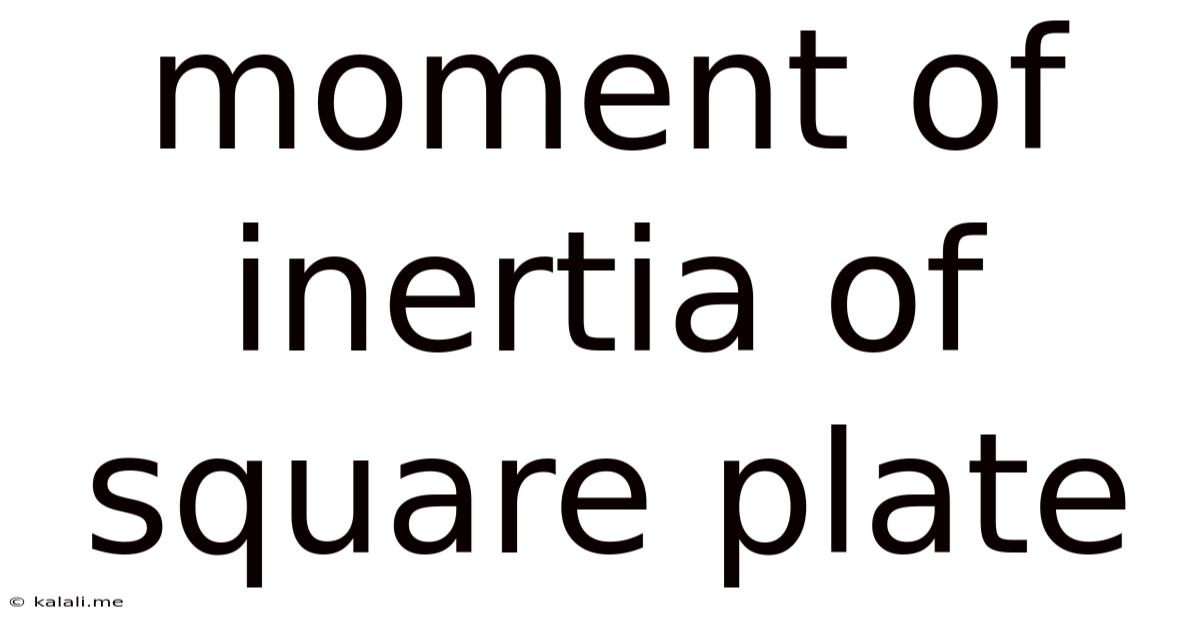Moment Of Inertia Of Square Plate
Kalali
Jun 13, 2025 · 3 min read

Table of Contents
Moment of Inertia of a Square Plate: A Comprehensive Guide
The moment of inertia, a crucial concept in physics and engineering, describes an object's resistance to changes in its rotation. This article will delve into the calculation of the moment of inertia of a square plate, exploring different axes of rotation and providing practical applications. Understanding this concept is essential for analyzing the rotational motion of various objects, from simple shapes like square plates to complex engineering components.
Understanding Moment of Inertia
Before diving into the specifics of a square plate, let's briefly revisit the fundamental definition of the moment of inertia (also known as rotational inertia). It represents the sum of the products of each particle's mass and the square of its distance from the axis of rotation. A higher moment of inertia indicates a greater resistance to changes in rotational speed. This resistance is influenced by both the mass distribution and the axis of rotation.
Moment of Inertia of a Square Plate: Different Axes
Calculating the moment of inertia of a square plate depends heavily on the chosen axis of rotation. Let's explore the most common scenarios:
1. Moment of Inertia about an Axis Through the Center, Parallel to a Side
Consider a square plate with side length 'a' and uniform mass density 'ρ'. The total mass 'M' is given by M = ρa². To find the moment of inertia (I) about an axis passing through the center and parallel to one of its sides, we can utilize integration. The formula derived through this process is:
I = (1/12)Ma²
This represents the simplest case, providing a baseline understanding for more complex scenarios.
2. Moment of Inertia about an Axis Through the Center, Perpendicular to the Plate
For an axis perpendicular to the plate and passing through its center, the moment of inertia is calculated using a different approach, again employing integration techniques. The formula for this axis of rotation is:
I = (1/6)Ma²
Notice the difference in the coefficient compared to the previous case. This highlights the significant impact of the axis of rotation on the moment of inertia.
3. Moment of Inertia about an Axis Through a Corner, Perpendicular to the Plate
This scenario introduces an axis of rotation that passes through one of the square plate's corners and is perpendicular to the plane of the plate. This calculation is more complex and usually involves the parallel axis theorem, which states:
I = I<sub>cm</sub> + Md²
where:
- I is the moment of inertia about the corner.
- I<sub>cm</sub> is the moment of inertia about a parallel axis through the center of mass (which we've already calculated).
- M is the mass of the plate.
- d is the distance between the two parallel axes (in this case, the distance from the center of the square to one of its corners).
Using the previously calculated I<sub>cm</sub> = (1/6)Ma² and d = a√2 / 2, the final equation becomes:
I = (1/6)Ma² + M(a√2/2)² = (2/3)Ma²
This illustrates how the moment of inertia increases significantly when the axis of rotation is shifted away from the center of mass.
Practical Applications
Understanding the moment of inertia of a square plate has numerous applications across various engineering disciplines:
- Mechanical Design: Calculating torsional stress and deflection in rotating components like gears or robotic arms.
- Structural Analysis: Determining the stability and resistance of structures to dynamic loads.
- Aerospace Engineering: Analyzing the rotational behavior of spacecraft components and predicting their responses to external forces.
- Physics Simulations: Accurate modeling of rotational motion in simulations requires precise calculations of moment of inertia.
Conclusion
Calculating the moment of inertia of a square plate involves understanding the fundamental concept of rotational inertia and the significant influence of the chosen axis of rotation. The formulas derived above provide a basis for analyzing the rotational behavior of square plates and can be extended to more complex shapes and scenarios using appropriate theorems and integration techniques. Mastering these concepts is crucial for anyone working with rotating systems in engineering, physics, and related fields.
Latest Posts
Latest Posts
-
Four Letter Word With Second Letter A
Jul 01, 2025
-
How Many 1 8 Cups Are In 2 3 Cup
Jul 01, 2025
-
How Many Slices Of Turkey In 2 Oz
Jul 01, 2025
-
Omnipoint Miami E License Llc Miami Fl
Jul 01, 2025
-
Mi Familia Fuera La M S Grande Correct Incorrect
Jul 01, 2025
Related Post
Thank you for visiting our website which covers about Moment Of Inertia Of Square Plate . We hope the information provided has been useful to you. Feel free to contact us if you have any questions or need further assistance. See you next time and don't miss to bookmark.